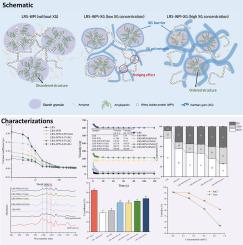Reinforced swallowing and anti-digestive performance of lotus root starch-whey isolate protein gel via weakening effect of xanthan gum
IF 12.5
1区 化学
Q1 CHEMISTRY, APPLIED
引用次数: 0
Abstract
To develop dysphagia-friendly, high-protein foods, this study selected xanthan gum (XG) as a texture modifier in a lotus root starch-whey protein isolate (LRS-WPI) composite system. According to the International Dysphagia Diet Standardization Initiative (IDDSI) framework, the incorporation of XG reduced the texture level of LRS-WPI gels from level 7 to level 4, enhancing their suitability for dysphagia patients. However, low addition-XG (0.05 %–0.10 %) promoted macromolecular clustering (≥1000 μm) through bridging interactions with WPI, which might not be conducive to the comfort of the swallowing process. While higher XG content increased gel viscosity beyond 600 cp and minimized oral friction, demonstrating its potential to prevent choking. During co-heating, XG raised the pasting temperature by approximately 10 °C and reduced amylose leaching. In vitro digestion revealed that 0.60 % XG reduced rapidly digestible starch by 30.07 % compared to the LRS. Results of water migration, intermolecular interactions, and microstructure suggested that XG disrupted the WPI gel network via hydrogen bonding and electrostatic interactions, and acted as a “lubricant” through self-assembled flexible gels. Additionally, XG hindered LRS digestion by constructing a physical barrier and competing for water. This article would offer valuable insights into improving the friendliness of high-protein dysphagia foods.

通过削弱黄原胶的作用增强藕粉分离乳清蛋白凝胶的吞咽和抗消化性能
为了开发对吞咽困难友好的高蛋白食品,本研究选择黄原胶(XG)作为藕淀粉-乳清分离蛋白(LRS-WPI)复合体系的质地调节剂。根据国际吞咽困难饮食标准化倡议(IDDSI)框架,XG的加入将LRS-WPI凝胶的质地等级从7级降低到4级,增强了其对吞咽困难患者的适应性。然而,低添加量的xg(0.05% ~ 0.10%)通过与WPI的桥接作用促进了大分子聚类(≥1000 μm),这可能不利于吞咽过程的舒适性。而较高的XG含量使凝胶粘度超过600 cp,并将口腔摩擦降至最低,显示出其防止窒息的潜力。在共加热过程中,XG将糊化温度提高了约10℃,减少了直链淀粉的浸出。体外消化试验表明,与LRS相比,0.60% XG可使快速消化淀粉减少30.07%。水迁移、分子间相互作用和微观结构的结果表明,XG通过氢键和静电相互作用破坏了WPI凝胶网络,并通过自组装柔性凝胶发挥了“润滑剂”的作用。此外,XG通过构建物理屏障和争夺水分来阻碍LRS的消化。本文将为改善高蛋白吞咽困难食物的友好性提供有价值的见解。
本文章由计算机程序翻译,如有差异,请以英文原文为准。
求助全文
约1分钟内获得全文
求助全文
来源期刊

Carbohydrate Polymers
化学-高分子科学
CiteScore
22.40
自引率
8.00%
发文量
1286
审稿时长
47 days
期刊介绍:
Carbohydrate Polymers stands as a prominent journal in the glycoscience field, dedicated to exploring and harnessing the potential of polysaccharides with applications spanning bioenergy, bioplastics, biomaterials, biorefining, chemistry, drug delivery, food, health, nanotechnology, packaging, paper, pharmaceuticals, medicine, oil recovery, textiles, tissue engineering, wood, and various aspects of glycoscience.
The journal emphasizes the central role of well-characterized carbohydrate polymers, highlighting their significance as the primary focus rather than a peripheral topic. Each paper must prominently feature at least one named carbohydrate polymer, evident in both citation and title, with a commitment to innovative research that advances scientific knowledge.
 求助内容:
求助内容: 应助结果提醒方式:
应助结果提醒方式:


